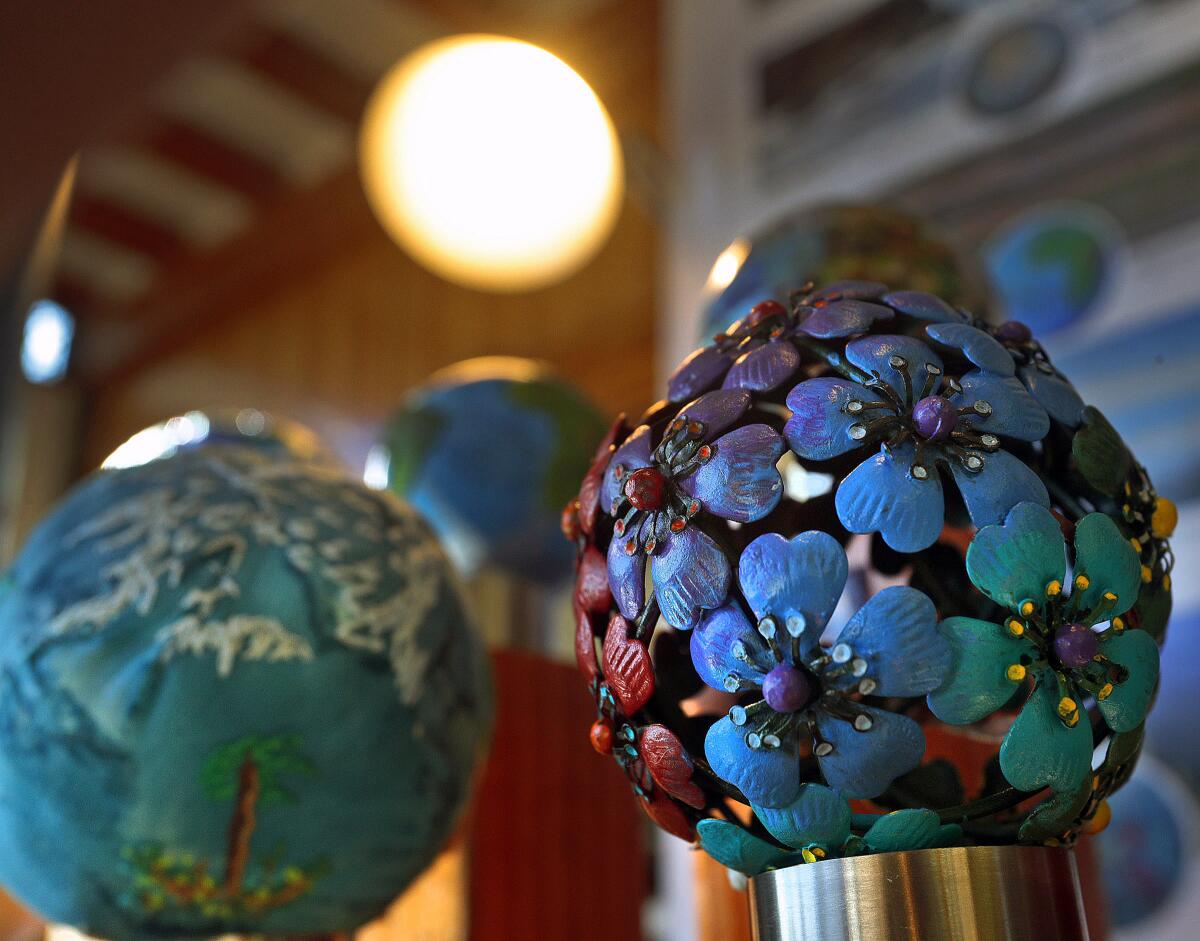Art campaign poses: What would you do if the earth were in your hands?

- Share via
La Cañada landscape architect Ronnie Siegel knows thinking about the enormity and inevitability of climate change can be overwhelming, but still she poses one simple question: What would you do if the earth was in your hands?
That question is at the heart of “Carry the Earth,” an interactive environmental art project Siegel created last year with the help of husband Peter and a handful of friends, in which participants ask for and receive one of 39 artfully rendered globes to hold onto for a while.
Each is designed with a different aspect of the planet and the environment in mind. Some are scientific, depicting migration and wind patterns, earthquake fault lines and polar ice caps.

Others invite holders to ponder news headlines, plastic in the oceans and the threat of rising sea levels, while conceptual globes, crocheted or rendered in glass, reference the universality of music or the threads that tie mankind together.
“Carry the Earth” asks recipients to let themselves become inspired by the art and the act of holding the planet in their hands, and then do something — anything — to honor that experience.
Siegel encourages people to share the process in a blog post with photos or videos that she curates at carrytheearth.com, and then pass on the globe. So far, more than 70 stories have been cataloged.

“It’s trying to encourage people to do something different that speaks to their own heart and talent and their own individuality,” she said. “The stories that we get are very diverse.”
A girl in the Netherlands and her family went vegetarian for one week and posted recipes. A young man in Peru shared his desire to work in eco-tourism instead of mining and logging industries that deplete Amazon River forestland.
In Columbia, poor women are learning to weave plastic bags from trash into salable goods. In August, a Dallas teacher took a globe — and 16 students — on a sustainable food tour through Italy.
Lisa Larson is a friend of Siegel’s and a “Carry the Earth” supporter. She took Earth 19, “Sounds Blend to Music” on a trip to visit her flutist daughter in Vienna and recorded her playing Vivaldi’s “Four Seasons” in a UNESCO World Heritage forest.
Earth 3, “Migration,” inspired her to think about water use — now she’s removing the lawn of her Monrovia home and studying drought-tolerant landscaping.

“This is a way to raise consciousness about the way we live our lives and what we can do to help the planet and the environment in small ways that might add up,” she said of the project.
Students enrolled in after-school programs run by La Cañada’s Childhood Educational Center spent time with Earth 2 “Ocean Currents Carrying Whales” this spring. They then held bake sales, raising $600 for the nonprofit One Tree Planted, which plants one tree for each dollar received.
CEC directors Lisa Cain-Chang and Allegra Inganni said Siegel’s project takes a heart-centered approach toward making tangible differences.
“This was a rallying point for the children to be able to spark that idea and say, what are we going to do?” Cain-Chang said. “It was very empowering.”
Inganni said children are still generating new ideas inspired by “Carry the Earth.”

Siegel is encouraged by the stories she’s collected and hopes the project will grow. She figures no one person can “solve” climate change, but if everyone who cares does something personally meaningful and connects with another, who acts in turn, huge things can happen.
“That’s why I started this, to see if I can do a little bit more to engage people and to build momentum and give people a sense of empowerment,” she said.
